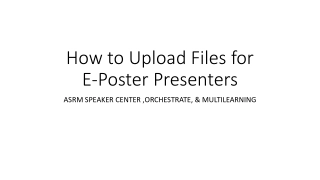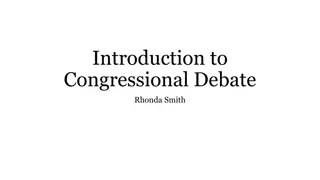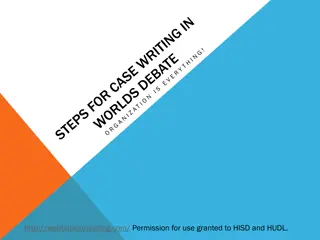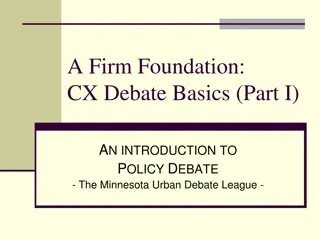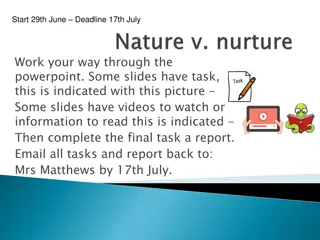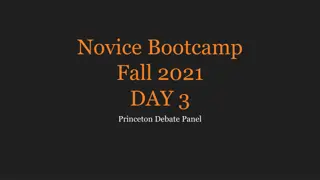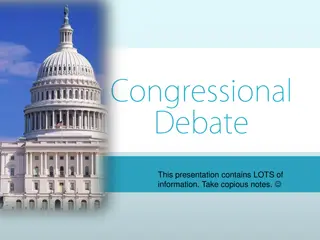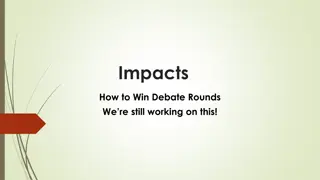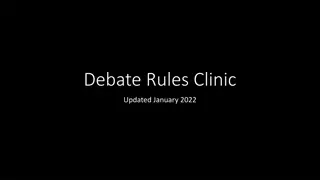An Introduction to Policy Debate and Speaker Responsibilities
Learn the format and key elements of policy debate as outlined by the National Federation of State High School Associations. Understand the roles and responsibilities of constructive and rebuttal speakers, along with the importance of cross-examination in presenting and defending arguments. Dive into stock issues like topicality, harm, inherency, solvency, and disadvantages to develop compelling cases and responses in competitive debate settings.
Download Presentation

Please find below an Image/Link to download the presentation.
The content on the website is provided AS IS for your information and personal use only. It may not be sold, licensed, or shared on other websites without obtaining consent from the author.If you encounter any issues during the download, it is possible that the publisher has removed the file from their server.
You are allowed to download the files provided on this website for personal or commercial use, subject to the condition that they are used lawfully. All files are the property of their respective owners.
The content on the website is provided AS IS for your information and personal use only. It may not be sold, licensed, or shared on other websites without obtaining consent from the author.
E N D
Presentation Transcript
POLICY DEBATE INTRODUCTION National Federation of State High School Associations A very brief introduction to policy debate, using some examples from the the Water Resources Topic, by Rich Edwards, Baylor University
THE FORMAT FOR POLICY DEBATE Constructive Speeches 1AC: 8 Minutes Cross-Examined by 2NC: 3 Minutes 1NC: 8 Minutes Cross-Examined by 1AC: 3 Minutes 2AC: 8 Minutes Cross-Examined by 1NC: 3 Minutes 2NC: 8 Minutes Cross-Examined by 2AC: 3 Minutes Rebuttal Speeches 1NR: 5 Minutes 1AR: 5 Minutes 2NR: 5 Minutes 2AR: 5 Minutes
THE STOCK ISSUES Topicality: Is it germane? Harm: Is there a significant problem? Inherency: What is causing the problem? Solvency: Can the problem be solved? Disadvantage: Will the solution create more serious problems than the ones it resolves? www.nfhs.org
CONSTRUCTIVE SPEAKER RESPONSIBILITIES 1AC: Present a Prima Facie Case Harm, Inherency, Solvency, Plan 1NC: Present the Negative Attack Traditionally attacked the 1AC More recently: The front-line of all negative positions (Topicality, Disadvantages, Counterplans, Kritiks) then answer the Case arguments 2AC: Re-Defends Against 1NC Follows 1NC point-by-point (Answer whatever the 1NC wanted to talk about) 2NC: Answer selected parts of the 2AC positions, leaving the rest for 1NR Divide positions with the 1NR (division of labor) www.nfhs.org
REBUTTAL SPEAKER RESPONSIBILITIES No new arguments in rebuttal (new evidence OK) 1NR: Answer remaining 2AC arguments 1AR: Answer all 2NC & 1NR arguments 2NR: Extend winning negative arguments 2AR: Answer all remaining negative arguments & claim all affirmative positions that are no longer contested www.nfhs.org
CROSS EXAMINATION The speaker completing the constructive speech remains at the podium for questions Both questioner and respondent face the judge The questioner controls the cross examination period What to ask? Set up arguments for later speeches Use all of your time (it s prep time for your partner) www.nfhs.org
KEEPING A FLOW SHEET Efforts to minimize the harm are symptomatic of the problem that we face; there is no question that children were harmed. Any amount of lead pollution is damaging. I. Lead pollution of drinking water threatens America s children. 1. Follow-up studies have questioned whether the harm levels in Flint were actually that serious. 2. In any case, the problem has now been addressed. A. The 2014-19 lead poisoning incident in Flint, Michigan proves the danger. The solutions were too little and too late to prevent the harm to Flint s children. The only lasting solution will come from the complete replacement of both municipal and residential water supply lines. B. Flint is only the tip of the iceberg; millions of U.S. children impacted. The level of lead pollution in drinking water has fallen significantly over the past several decades. Our evidence shows that millions of children continue to be impacted by lead pollution. C. Lead poisoning causes permanent learning disabilities. Trace amounts of lead in drinking water are not significantly harmful. There is no safe amount of lead contamination; even trace amounts can continue to cause harm. www.nfhs.org
FLOW SHEET TIPS Use abbreviations appropriate to the topic (W=water; Pb=Lead pollution, CC=Climate Change, Wet=wetlands, etc.) Use symbols for common claims: (up arrow for increasing, down arrow for decreasing, right arrow for causes or results in , etc.) Establish priorities: 1. Contention labels first priority, 2. Subpoints second priority, 3. Evidence reference third priority (Davis 21), 4. Key words of evidence fourth priority. Ask for missed points (in CX or prep time). Use lots of paper (separate sheets for plan arguments and for case arguments; each big argument should have its own sheet). Line up flowsheet paper with debaters road-maps www.nfhs.org
POLICY DEBATE INTRODUCTION www.nfhs.org


